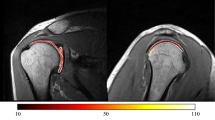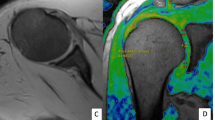Abstract
Objective
The purpose of this study was to assess the T2 values of the glenohumeral joint cartilage in healthy asymptomatic individuals at 3.0 T and to analyze the T2 profile of the humeral cartilage.
Materials and methods
This prospective study was approved by our institutional review board and written informed consent was obtained. Thirteen subjects (mean age, 28.6 years; age range, 24–33 years) were included and underwent multiecho spin-echo T2-weighted MR imaging and T2 mapping was acquired. Regions of interest were placed on the humeral cartilage and glenoid cartilage on oblique coronal images. T2 profiles of humeral cartilage were measured from the bone–cartilage interface to the articular surface. Intra-observer agreement was analyzed using intraclass correlation coefficient (ICC).
Results
All 13 joints showed normal appearance on conventional T2-weighted images. The mean T2 values of humeral and glenoid cartilage were 50.5 ± 12.1 and 49.0 ± 9.9 ms, respectively. Intra-observer agreement was good, as determined by ICC (0.736). Longer T2 values were observed at the articular surface with a tendency to decrease toward the bone–cartilage interface. The mean cartilage T2 value was 69.03 ± 21.2 ms at the articular surface and 46.99 ± 19.6 ms at the bone–cartilage interface.
Conclusion
T2 values of the glenohumeral joint cartilage were similar to reported values of cartilage in the knee. The T2 profile of normal humeral cartilage showed a spatial variation with an increase in T2 values from the subchondral bone to the articular surface.




Similar content being viewed by others
References
Neer 2nd CS. Replacement arthroplasty for glenohumeral osteoarthritis. J Bone Joint Surg Am. 1974;56(1):1–13.
Ellman H, Harris E, Kay SP. Early degenerative joint disease simulating impingement syndrome: arthroscopic findings. Arthrosc: J Arthrosc Relat Surg: Off Publ Arthrosc Assoc N Am Int Arthrosc Assoc. 1992;8(4):482–7.
Feeney MS, O'Dowd J, Kay EW, Colville J, et al. Glenohumeral articular cartilage changes in rotator cuff disease. J Should Elb Surg/Am Should Elb Surg. 2003;12(1):20–3.
Guntern DV, Pfirrmann CW, Schmid MR, Zanetti M, Binkert CA, Schneeberger AG, et al. Articular cartilage lesions of the glenohumeral joint: diagnostic effectiveness of MR arthrography and prevalence in patients with subacromial impingement syndrome. Radiology. 2003;226(1):165–70.
Dietrich TJ, Zanetti M, Saupe N, Pfirrmann CW, Fucentese SF, Hodler J. Articular cartilage and labral lesions of the glenohumeral joint: diagnostic performance of 3D water-excitation true FISP MR arthrography. Skelet Radiol. 2010;39(5):473–80.
McCauley TR, Recht MP, Disler DG. Clinical imaging of articular cartilage in the knee. Semin Musculoskelet Radiol. 2001;5(4):293–304.
Mosher TJ, Dardzinski BJ. Cartilage MRI T2 relaxation time mapping: overview and applications. Semin Musculoskelet Radiol. 2004;8(4):355–68.
Apprich S, Mamisch TC, Welsch GH, Stelzeneder D, Albers C, Totzke U, et al. Quantitative T2 mapping of the patella at 3.0T is sensitive to early cartilage degeneration, but also to loading of the knee. Eur J Radiol. 2012;81(4):e438–43.
Dardzinski BJ, Mosher TJ, Li S, Van Slyke MA, Smith MB. Spatial variation of T2 in human articular cartilage. Radiology. 1997;205(2):546–50.
Dunn TC, Lu Y, Jin H, Ries MD, Majumdar S. T2 relaxation time of cartilage at MR imaging: comparison with severity of knee osteoarthritis. Radiology. 2004;232(2):592–8.
Mamisch TC, Trattnig S, Quirbach S, Marlovits S, White LM, Welsch GH. Quantitative T2 mapping of knee cartilage: differentiation of healthy control cartilage and cartilage repair tissue in the knee with unloading—initial results. Radiology. 2010;254(3):818–26.
Karmazyn B, Lin C, Persohn SA, Buckwalter KA. Feasibility of mapping T2 relaxation time in the pediatric metacarpal head with a 3-T MRI system. AJR Am J Roentgenol. 2012;198(6):W602–4.
Lazovic-Stojkovic J, Mosher TJ, Smith HE, Yang QX, Dardzinski BJ, Smith MB. Interphalangeal joint cartilage: high-spatial-resolution in vivo MR T2 mapping—a feasibility study. Radiology. 2004;233(1):292–6.
Welsch GH, Mamisch TC, Weber M, Horger W, Bohndorf K, Trattnig S. High-resolution morphological and biochemical imaging of articular cartilage of the ankle joint at 3.0 T using a new dedicated phased array coil: in vivo reproducibility study. Skelet Radiol. 2008;37(6):519–26.
Maizlin ZV, Clement JJ, Patola WB, Fenton DM, Gillies JH, Vos PM, et al. T2 mapping of articular cartilage of glenohumeral joint with routine MRI correlation: initial experience. HSS J: Musculoskelet J Hosp Spec Surg. 2009;5(1):61–6.
Lee SY, Park HJ, Kwon HJ, Kim MS, Choi SH, Choi YJ, et al. T2 relaxation times of the glenohumeral joint at 3.0 T MRI in patients with and without primary and secondary osteoarthritis. Acta Radiol. 2015;56(11):1388–95.
Goodwin DW, Zhu H, Dunn JF. In vitro MR imaging of hyaline cartilage: correlation with scanning electron microscopy. AJR Am J Roentgenol. 2000;174(2):405–9.
Mosher TJ, Dardzinski BJ, Smith MB. Human articular cartilage: influence of aging and early symptomatic degeneration on the spatial variation of T2—preliminary findings at 3 T. Radiology. 2000;214(1):259–66.
Smith HE, Mosher TJ, Dardzinski BJ, Collins BG, Collins CM, Yang QX, et al. Spatial variation in cartilage T2 of the knee. J Magn Reson Imaging. 2001;14(1):50–5.
Nieminen MT, Rieppo J, Toyras J, Hakumaki JM, Silvennoinen J, Hyttinen MM, et al. T2 relaxation reveals spatial collagen architecture in articular cartilage: a comparative quantitative MRI and polarized light microscopic study. Magn Reson Med: Off J Soc Magn Reson Med/Soc Magn Reson Med. 2001;46(3):487–93.
Yeh LR, Kwak S, Kim YS, Chou DS, Muhle C, Skaf A, et al. Evaluation of articular cartilage thickness of the humeral head and the glenoid fossa by MR arthrography: anatomic correlation in cadavers. Skelet Radiol. 1998;27(9):500–4.
Grant support
This study was partially supported by grant No. 02-2012-051 from the SNUBH Research Fund and partially by Basic Science Research Program through the National Research Foundation of Korea (NRF) funded by the Ministry of Education, Science and Technology (NRF-2012R1A1A3010896).
Author information
Authors and Affiliations
Corresponding author
Ethics declarations
Conflict of interest
The authors declare that they have no competing interests
Ethical approval
All procedures performed in studies involving human participants were in accordance with the ethical standards of the institutional and/or national research committee and with the 1964 Helsinki declaration and its later amendments or comparable ethical standards.
Informed consent
Informed consent was obtained from all individual participants included in the study.
Rights and permissions
About this article
Cite this article
Kang, Y., Choi, JA. T2 mapping of articular cartilage of the glenohumeral joint at 3.0 T in healthy volunteers: a feasibility study. Skeletal Radiol 45, 915–920 (2016). https://doi.org/10.1007/s00256-016-2398-3
Received:
Revised:
Accepted:
Published:
Issue Date:
DOI: https://doi.org/10.1007/s00256-016-2398-3




